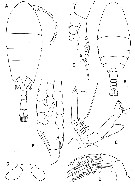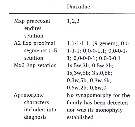|
|
 |
|
Calanoida ( Order ) |
|
|
|
Arietelloidea ( Superfamily ) |
|
|
| |
| | | |
| Discoidae Gordeeva, 1975 ( Arietelloidea ) | | Ref.: | Gordeeva, 1975 (p.189); Bowman & Abele, 1982 (p.9); Razouls, 1982 (p.521); Huys & Boxshall, 1991 (p.419); Razouls, 1993 (p.306); Bradford-Grieve,1999 b (p.68, Def., Rem.); Ohtsuka & Huys, 2001 (p.461); Boxshall & Halsey, 2004 (p.12, 14; 49; 108: Def.; p.110: Key of Genera); Vives & Shmeleva, 2007 (p.271, Key of Genera); Andronov & Kosobokova, 2011 (p.38, Rem.)
Bradford-Grieve J.M., (2002 onwards). Key to calanoid copepod families. Version 1 : 2 oct 2002. http://www.crustacea.net/crustace/calanoida/index.htm  | | Rem.: | Type-genus: Disco Grice & Hulsemann, 1965. Total: 4 G.: Disco, Paradisco, Prodisco, Pertsovius.
For Andronov & Kosobokova (p.38-39) several species within the family Discoidae are very similar to each other; Park (1970) and Schulz 1993) noted their close similarity, which could warrant their placement within a unique taxonomic clade. The discovery of three additional species affiliated with this clade in the Arctic Ocean further warrants erection of a distinct genus: Pertsovius comprising henceforth 7 species.
Definition after Bradford-Grieve (1999, p.68) Female:
- Prosome an elongate-oval.
- Forehead rounded.
- Rostrum of a simple plate, rounded or weakly incised terminally or completely absent.
- Cephalosome and pediger 1 separate, sometimes not entirely, pedigers 4 and 5 fused.
- Posterior corners of last thoracic segment rounded, in a few species directed ventrally.
- Urosome 4-segmented, its length equal to at least half the length of prosome.
- Genital segment of various forms, in Prodisco it has sac-like outgrowths laterally.
- Anal segment is longer than (only sometimes almost equal to) caudal rami.
- Caudal rami long or short, symmetrical, with 4 terminal equal setae or of various lengths and thicknesses.
A1 shorter than body, 17-26 free segments, furnished along whole length with simple and sensory setae.
- A2 endopod shorter than exopod; basipod 2 with 0-1 setae; endopod segment 1 with 0-1 seta, segment 2 with 6-14 setae; exopod variable, 5-9-segmented with 4-10 setae.
- Mouthparts considerably reduced, their ventral expression weak.
- Md blade with 2 or more strong teeth; basipod usually without setae; endopod segment 1 with 0-2 setae, segment 2 with 2-8 setae; exopod with 5-6 setae.
- Mx1 variable with reduced number of setae and lobes; inner lobe1 with 2-6 spines and setae; inner lobe 2 absent or with 1-2 setae; inner lobe 3 absent or with 1-3 setae; basipod absent or with 0-2 setae; endopod absent or with 3-8 setae; exopod absent or with 2-7 setae; outer lobe 2 absent or with 1 seta; outer lobe 1 with 2-6 setae.
- Mx2 lobes 1-5 with 2-4, 1-2, 2, 1-2, 1-2 setae respectively, endopod with 3-4 setae or reduced to a simple 1-2-segment lobe with 3-8 setae.
- Mxp basipod 1 with 2-6 setae; basipod 2 with 0-2 setae: endopod 5-segmented with 1-2, 1-2, 1-2, 0-3, 1-4 setae respectively or reduced to a 6-segment rod with 1-4 terminal setae.
- Swimming legs with varying degrees of fusion between endopod segments; P1 endopod 1-3-segmented, more usually 2-segmented. P2-P4 endopods usually 3-segmented althought may be 1-segmented.
Male:
- Urosome 5-segmented.
- In Prodisco the genital segment slightly asymmetrical lateral extensions.
- A1 setae particularly abundant; lef A1 geniculate; 3 or more free segments distal to joint.
- Mouthparts reduced relative to female. |  Issued from : G.A. Boxshall & S.H. Halsey in An Introduction to Copepod Diversity. The Ray Society, 2004, No 166, Part. I. [p.108]. Armature formula of swimming legs P1 to P4. Setation sometimes reduced, especially on endopods in species with reduced endopodal segmentation, such as Disco longus Grice & Hulsemann. Exopodal segment 3 of P2 only, or of P2 to P45 with only 2 outer margin spines in some species. Nota: Female P5 typically reduced to small transverse plate with unarmed lateral lobes. P5 apparently 3-segmented in Paradisco grandis (Gordejeva). - Male P5 asymmetrical; right leg slightly longer than left. Both legs with 3-segmented exopod and 2-segmented endopod (in Disco fjordicus): disyal endopodal segment club-shaped and ornamented with tuft of setules. 2nd exopodal segments transformed, right with inner groove, left with inner process. Endopods may be 1 to 3-segmented. - Eggs presumably released into water. |
 Issued from : G.A. Boxshall & S.H. Halsey in An Introduction to Copepod Diversity. The Ray Society, 2004, No 166, Part. I. [p.109, Fiug.20]. Discoidae. A, Prodisco princeps habitus female; B, Disco hartmanni habitus female; C, A2; D, Mx2; E, P1; F, Disco fjordicus male P5; G, Paradisco nudus female P5. ’Gordejeva, 1975: A; Schulz, 1993: B-E, G; Fosshagen, 1967: F]. |
 Issued from : J.M. Bradford-Grieve in NIWA Biodiversity Memoir 111, 1999. [p/68]. Spine and seta formula of swimming legs P1 to P4. - P5 female strongly reduced or absent. - P5 male strongly modified and variable; right and left legs uniramous or biramous, asymmetrical, little different in length; endopods, if present, 1-3-segmented; exopods 3-segmented with terminal setae, segments 1 and 2 usually without setae, segment 2 sometimes has an inner projection. |
 Issued from : S. Laakmann, E.L. Markhaseva & J. Renz in Mol. Phylog. Evol., 2019, 130. [p.331, Table 1]. compilation of information on relationships among ''Bradfodian'' genera from Markhaseva & Ferrari 2005) and Markhaseva & al. (2014). Abbreviations: A2, antenna; Md, mandible; Mx1, maxillule; Mx2, maxilla; Mxp, maxilliped ; P5, leg 5. w, worm-like sensory seta; b, brush-like sensory seta; s, sclerotized seta.; | | | | | (1) Disco Grice & Hulsemann, 1965 | |
| | Ref.: | Grice & Hulsemann, 1965 (p.256); Fosshagen, 1967 (p.319); Matthews, 1972 (p.4); Gordeeva, 1974 (p.841); 1974 a (p.1148); 1974 b (p.1414); 1975 (p.188); Razouls, 1982 (p.521); 1993 (p.306); Schulz, 1993 (p.200, Rem.); Mauchline, 1998 (p.66, 77: F; p.76: M); Bradford-Grieve,1999 b (p.69, Def.); Schulz, 2003 (p.110, Rem.); Boxshall & Halsey, 2004 (p.110); Vives & Shmeleva, 2007 (p.272, spp. key) | | Rem.: | This genus is established by Grice and Hulsemann to include three females (males being unknown) determining each one three different species. In 1967, the male of D. inflatus was described as well as a second male not identified to one of the known species. The authors regard this genus as belonging to the family Augaptilidae, followed by Matthews (1972). Fosshagen (1967) estimates that the characteristics of the females hardly allow a such a classification. Gordeeva (1974 a and b) described several new species and creates in 1975 two new genera which are included in the new family of Discoidae.
Andronov & Kosobokova (2011, p.38) transfer 4 species earlier in the genus Disco within a new genus Pertsovius which includes henceforth 7 species.
Type: Disco inflatus Grice & Hulsemann, 1965. Total: 18 spp. + 1 unspecified.
Diagnosis after Bradford-Grieve (1999 b, p.69) :
- As in the family definition.
- Small copepods generally less than 1 mm in length.
- Rostrum large and obtusely rounded or absent.
- Anal segment longer than the preceding segment.
- A1 17-26-segmented; of a reduced number of segments in male left geniculate.
- A2 endopod about 2/3 the length of exopod which is 6-8 segmented; distal segment of exopod equals approximately 1/2 the length of entire exopod.
- Md endopod usually longer than exopod; blade with spine-like teeth.
- Mx1, Mx2 and Mxp with varying degrees of reduction.
- Male Mx1, Mx2 and Mxp slightly reduced compared with female.
- P1 endopods usually 2-segmented, sometimes 1-segmented.
- P2-P3 endopod usually 3-segmented but may have all segments fused.
- Female P5 rudimentary or absent.
- Male P5 uniramous or biramous. | | Remarks on dimensions and sex ratio: | | The mean female size is 0.554 (n = 24; SD = 1.779), and the mean male size is 0.575 (n = 6; SD = 0.0338).
Nota the Arctic species (Disco triangularis Markhaseva & Kobosokova, 1998) not included in the calcul, because its great body size: 1.35-1.40 mm. | | | | | (2) Paradisco Gordeeva, 1975 | |
| | Ref.: | Gordeeva, 1975 (p.192); Razouls, 1982 (p.524); 1993 (p.306); Schulz, 1993 (p.205); Mauchline, 1998 (p.73: F; p.74: M); Bradford-Grieve,1999 b (p.69, Def.); Boxshall & Halsey, 2004 (p.110); Vives & Shmeleva, 2007 (p.286, spp. key) | | Rem.: | Type: Paradisco gracilis Gordeeva, 1975. Total: 4 spp.
Diagnosis after Bradford-Grieve (1999 b, p.69) :
- As in the family definition.
- Small copepods < 1 mm.
- Rostrum 1-branched, tapering, rounded at tip or with a small excavation.
- Anal segment slightly longer than previous segment or nearly equal to it.
- A1 comparatively long, 26-segmented, extending to the middle of genital segment.
- A2 endopod long about 2/3 yje length of exopod; exopod usually bullt - the 2-segmented distal part is articulated and movable with the proximal part, the terminal segment is short, equal to only 1/3 the length of the whole exopod.
- Md with thorn-like teeth; endopod of palp nearly equal to length of exopod, its terminal segment in the form of a wide lobe.
- Mx1 with 3-5 setae on 1st inner lobe.
- Mx2 with 5 lobes on basipod, carrying long flatly lying setae, and a reduced endopod with smooth setae.
- Mxp with a reduced number of setae on the inner border, setae normal, low-lying.
- All swimming legs with endopods 3-segmented.
- Female P5 rudimentary, symmetrical, 1-3-segmented.
- Male P5 strongly modified, biramous, asymmetrical, right and left legs slightly different in length. | | Remarks on dimensions and sex ratio: | | Females: Mean = 0,533 mm (n= 4). Males: Mean = 0,520 mm (n= 3). The size ratio male/female = 0.094. | | | | (3) Pertsovius Andronov & Kosobokova, 2011 | |
| | Ref.: | Andronov & Kosobokova, 2011 (p.38) | | Rem.: | Type species: Pertsovius tridentatus Andronov & Kosobokova, 2011. Total: 7 spp. | | | | (4) Prodisco Gordeeva, 1975 | |
| | Ref.: | Gordeeva, 1975 (p.189); Razouls, 1982 (p.525); 1993 (p.307); Mauchline, 1998 (p.76);Bradford-Grieve,1999 b (p.69, Déf.); Boxshall & Halsey, 2004 (p.110); Vives & Shmeleva, 2007 (p.289) | | Rem.: | Type: Prodisco princeps Gordeeva, 1975. Total: 2 spp.
Diagnosis after Bradford-Grieve (1999 b, p.69) :
- As in the family definition.
- Small copepods <0.5 mm.
- Body compact, similar to some representatives of the Cyclopoida.
- Close yo the genus Disco, but differs in the form of genital segment, small number of exopodal segments in A2, and the strongly extended posterior corners of the last metasomal segment.
- Head and pedigerous segment 1 separate, pedigerous segments 4 and 5 fused.
- Rostrum in the form of a plate, rounded at its tip, or absent.
- Urosome female 4-segmented; genital segment large, long, with lateral sac-like outgrowths extending ventrally, in which the genital products are stored.
- Anal segment longer than preceding segment and caudal rami.
- Caudal rami carry 4 terminal setae of different lengths.
- ,A2 endopod equal to 2/3 the length of exopod, male from 4 segments, distal segment a little less than half the length of whole exopod.
- Md palp endopod not much longer than exopod.
- Mouthparts and their ventral expression strongly reduced.
- Swimming legs with their exopods 3-segmented.
- Endopod on P1 2-segmented, on other leg 3-segmented; inner border of exopod segment 3 of P1 with 4 setae, of P2-P4 with 5 setae.
- P5 female absent; rudimentary in the male. | | | | |
|
|
 Any use of this site for a publication will be mentioned with the following reference : Any use of this site for a publication will be mentioned with the following reference :
Razouls C., Desreumaux N., Kouwenberg J. and de Bovée F., 2005-2026. - Biodiversity of Marine Planktonic Copepods (morphology, geographical distribution and biological data). Sorbonne University, CNRS. Available at http://copepodes.obs-banyuls.fr/en [Accessed January 18, 2026] © copyright 2005-2026 Sorbonne University, CNRS
|
|
 |
 |





